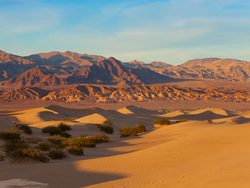
Death Valley National Park
Quick Navigation
Death Valley National Park is located in the southcentral part of eastern California. The park runs along the border of California and Nevada. The park covers an area of 5,270 square miles (13,650 sq km) making it the largest national park in the lower 48 contiguous states. Four national parks in Alaska are all larger with Wrangell-St. Elias being the largest.
The park is comprised of Death Valley, portions of Panamint Valley in the north, Eureka Valley in the south, and much of Saline Valley and serves as the foundation for the UNESCO’s Mojave and Colorado Deserts Biosphere Reserve.
Statistically speaking, Death Valley is the driest, hottest, and lowest of all the national parks in the United States. At 282 feet (86 m) below sea level, Badwater Basin is the lowest elevation in North America. The lowest elevation in the world occurs at the Dead Sea with an elevation of 1,341 feet (409 m) below sea level.
The landscapes are arid but vibrant, desolate but full of life, and vastness that delivers intricate uniqueness. The national park features sculpted badlands, canyons, and mountains, brilliant sand dunes and endless salt-flats. The park intertwines the ecology of both the Great Basin and the Mojave Desert.
Death Valley can be shadowed by rugged peaks blanketed with winter snows and decorated with wildflowers during rains the bless the scorched earth. The ecosystem is arid, dry, and hot but life still finds a way to exist.
Black brush, mesquite, Joshua tree, bristlecone pine, sage, and desert holly make up some of the vegetation that has adapted to the harsh environments and gives way to wildlife. There are over 50 species of mammals, 36 species of reptiles, and over 300 species of birds.
The popular wildlife species of the park include bighorn sheep, bobcat, fox, cougar, coyote, and mule deer. The best chance to see any wildlife is during the early hours around dawn and even hours around dusk.
Highlights
Death Valley is one of the darkest places in North America creating brilliant skies sparkling from horizon to horizon. For those who stay in the park through the evening can be left stand at awe at the starlit skies. If you wanted to count them, now would be a great chance because they won’t get any brighter.
 Mojave Desert
Mojave Desert
The Mojave Desert is larger than Death Valley itself while it extends into portions of Arizona and Utah. It covers an area of 47,877 Square miles (124,000 sq km).
The Joshua Tree is endemic and only found within the Mojave Desert ecosystem which includes as many as 2,000 species of vegetation.
The Mohave Desert is the driest desert in North America. Situated on the leeward side of the mountains, the Mojave is a rain shadow desert.
Badwater Basin
The Badwater Basin holds the record as the lowest elevation in North America. Mount Whitney is the highest elevation in the lower 48 contiguous United States, and it sits only 84.6 miles (136 km) to the northwest of the basin.
Badwater Basin is an endorheic basin with an elevation depth of 282 feet (86 m) below sea level. The rare rains will fill the basin with water; however, the formed bodies of water quickly evaporate away.
Furnace Creek
There is the Furnace Creek Visitor Center and museum to help introduce you to the park, this highlight of the region, and the best ways to enjoy the area. The area gives you access to Golden Canyon Interpretive Trail, Badwater Basin, and many other trails and natural facets of the park.
Furnace Creek holds the record for the hottest recorded temperature in North America at 134 oF (56.7 oC) and second in the world after the record was broken in Libya by two degrees.
Furnace Creek is blessed with an oasis that delivers shade through a neighboring date-palm grove. The town has a population of just over 20 residents.
Death Valley National Park Trails
Death Valley is arid making the need for managed or constructed trails irrelevant. The majority of hikes travel across the desert floor, through canyons, or along the ridges of the mountains.
Death Valley Highlights
- Badwater Basin
- Mojave Desert
- Furnace Creek
- Night skies and stargazing
Park Map
Sources
- American Southwest, Badwater, Death Valley National Park, https://www.americansouthwest.net/california/death_valley/badwater.html, retrieved June 2020.
- Britannica, Death Valley, https://www.britannica.com/place/Death-Valley, retrieved June 2020.
- Britannica, Glacier Bay National Park, https://www.britannica.com/place/Death-Valley-National-Park, retrieved June 2020.
- California, Death Valley National Park, https://www.visitcalifornia.com/destination/spotlight-death-valley-national-park, retrieved June 2020.
- National Geographic, Death Valley National Park, https://www.nationalgeographic.com/travel/national-parks/death-valley-national-park/, retrieved June 2020.
- National Geographic, Complete National Parks of the United States, National Geographic Publishing, Washington DC.
- National Geographic, Guide to the National Parks of the United States, National Geographic Society, 2003.
- National Geographic, National Parks of North America, Canada-United States-Mexico, National Geographic Society, 1995.
- National Park Service, Death Valley, https://www.nps.gov/deva/index.htm, retrieved June 2020.
- UNESCO, Mojave and Colorado Deserts, http://www.unesco.org/mabdb/br/brdir/directory/biores.asp?mode=all&Code=USA+39, retrieved June 2020.
- Wikipedia, Mojave Desert, https://en.wikipedia.org/wiki/Mojave_Desert, retrieved June 2020.

















